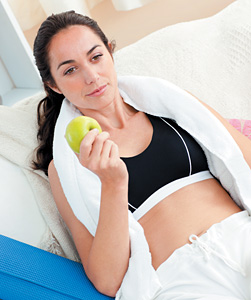Endurance and recreational athletes alike may experience glycogen depletion during exercise, known in athletic circles as "hitting the wall." When eaten, carbohydrates break down into small sugars (glucose, fructose and galactose) that get absorbed and used as energy.
Failing to meet overall nutritional needs or achieve specific nutritional support for an exercise session is likely to impair acute performance and even reduce the effectiveness of training or recovery.1-2 When this occurs, the athlete can experience symptoms such as lightheadedness, dizziness, heavy leg sensation or even hallucinations.
The source of carbohydrates is important to the athlete when it comes to preventing them from "hitting the wall" and improving their performance, particularly in the endurance athlete. Complex carbohydrates are preferred over simple sugars (empty calories). Complex carbohydrates are denser and result in greater storage capacity in the muscles. In our practice, I tell my athletes that the most effective period for carbohydrate loading is approximately 2-4 hours after exercise; this is when the muscles are most sensitive to insulin. I also emphasize that if blood sugar is kept elevated post-exercise, maximum glycogen synthesis will occur. Therefore, consuming adequate food (and fluid) before, during and after exercise can help maintain blood glucose during exercise, maximize exercise performance, and improve recovery time.3
 For the track-and-field (endurance) athletes I train, I'll sometimes recommend classic carbohydrate loading, because it can double or triple muscle glycogen and maximize performance. It's important to remember that this is only to be used about 2-3 times a year, specifically for endurance events.
For the track-and-field (endurance) athletes I train, I'll sometimes recommend classic carbohydrate loading, because it can double or triple muscle glycogen and maximize performance. It's important to remember that this is only to be used about 2-3 times a year, specifically for endurance events.
About one week before an event, training sessions are generally hard or moderate training, and diet consists of about 15 percent carbohydrates (350 grams), 15 percent protein and 70 percent fat. Three days before the event is when carbohydrate loading begins. This consists of about 550 grams of carbohydrate for men and 450 grams for women (or 8 grams per kg / 2.2 lbs body-weight). I generally don't recommend deserts or other sweet items that are high in carbohydrate because they are also high in sugars and fatigue the athlete. Yogurts, raisins and fresh fruits are better choices. (For example, a ½ cup of chocolate pudding provides about 30 grams carbohydrate, whereas a medium banana – which, unlike pudding, has no added / artificial sugars and is loaded with potassium and other electrolytes – has almost the same amount of carbs: 26 grams!)
Athletes should be well-hydrated before beginning exercise and drink enough fluid during and after exercise to balance fluid losses.3 My athletes hyper-hydrate 24 hours before their event, but no soft drinks are allowed (fruit juices are acceptable); generally 1 oz. water/juice for every pound of body weight. On the day of competition, they need a pre-event breakfast. This should consist up to at least 125 gram minimum or about 500 kcal carbohydrates (1 gram carbohydrate equals 4 kcal).
A sample pre-event breakfast consists of two English muffins, 2 tbsp. cottage cheese, 1 tbsp. low-sugar jam, ½ cantaloupe and 1 whole banana. The nutrient breakdown is roughly 570 kcal at 75 percent carb, 12 percent fat and 13 percent protein. Carbohydrates are needed to perform. However, remember that the athlete must avoid ingesting simple sugars (glucose or sucrose) ½ hour to two hours before their event because, as mentioned, it stimulates insulin activity that may result in low blood sugar (hypoglycemia; "hitting the wall").
According to Burke, the timing of the meal and its composition are equally important factors influencing performance. Lack of appropriate nutritional support will reduce exercise adaptation and impair preparation for future exercise sessions. The athlete could experience hypoglycemia, iron-deficiency anemia and early fatigue as a result.
Remember that the pre-event meal should be ingested 2-3 hours before their event and should consist of primarily complex carbohydrates. Solid foods are recommended. If the event exceeds two hours, the athlete can begin ingestion of liquid carbohydrates.
References
- Burke LM, King CJ. Ramadam fasting and the goals of sports nutrition around exercise. Sports Sci, 2012 Jul;30(sup1):S21-S31.
- Burke L. Fasting and recovery from exercise. Br J Sports Med, 2010 Jun;44(7):502-8.
- Position of the American Dietetic Association, Dietitians of Canada, and the American College of Sports Medicine: nutrition and athletic performance. J Am Diet Assoc, 2000 Dec;100(12):1543-56.
Click here for previous articles by Nancy Martin-Molina, DC, QME, MBA, CCSP.





